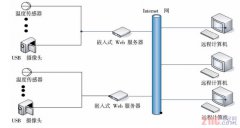STM32 USB虚拟串口 -
[导读]串口调试在项目中被使用越来越多,串口资源的紧缺也变的尤为突出。很多本本人群,更是深有体会,不准备一个USB转串口工具就没办法进行开发。本章节来简单概述STM32低端芯片上的USB虚拟串口的移植。在官方DEMO中已经提
串口调试在项目中被使用越来越多,串口资源的紧缺也变的尤为突出。很多本本人群,更是深有体会,不准备一个USB转串口工具就没办法进行开发。本章节来简单概述STM32低端芯片上的USB虚拟串口的移植。在官方DEMO中已经提供了现成的程序,这里对修改方法做简单说明。
本文引用地址: http://www.21ic.com/app/mcu/201808/784487.htm
首先打开官方demo我们开始进行移植,第一步复制我们可用的文件,操作如下:
ProjectsVirtual_COM_Port文件夹下,复制红线部分
图1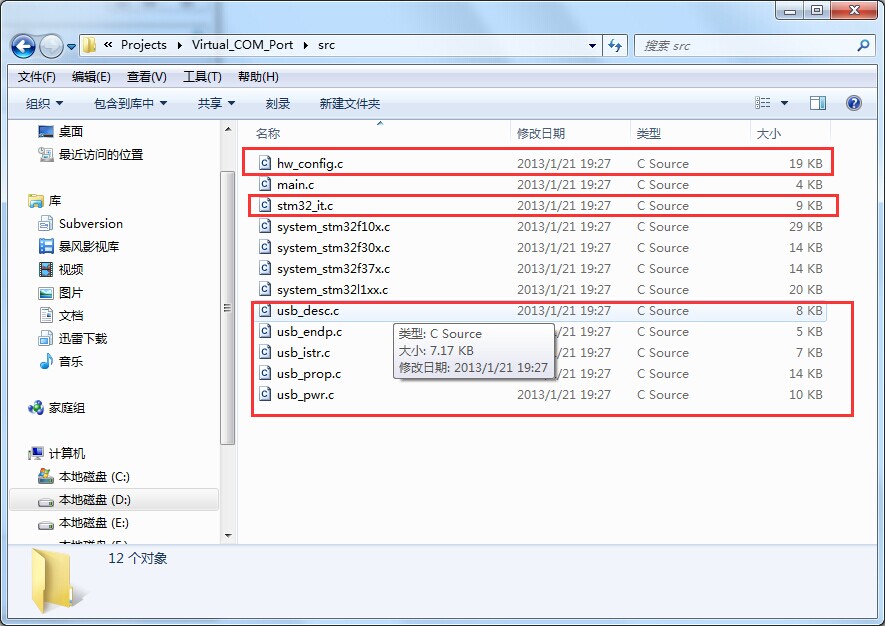
图2
我为了方便演示统放在usb/src文件夹下:
图3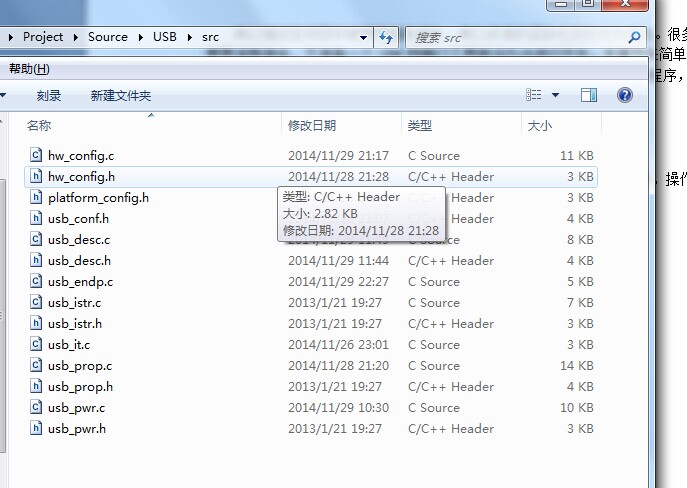
现在复制USB的库文件,这些文件不需要我们修改:
图4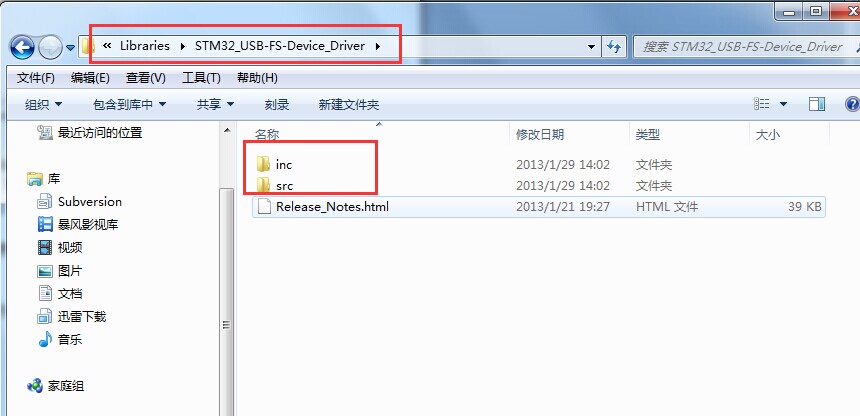
上图中的文件统一放在usb/lib文件夹下:
图5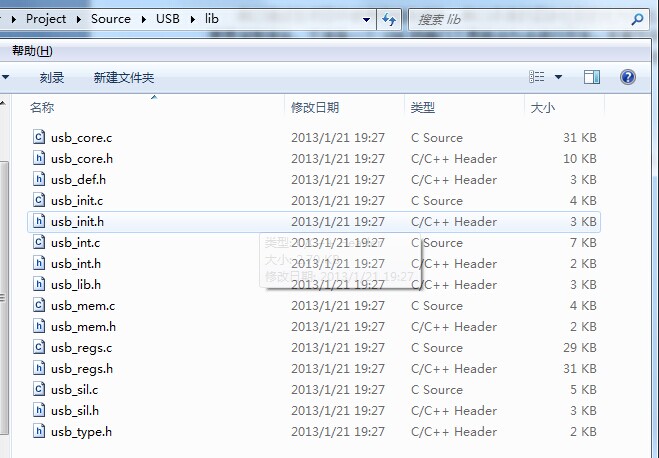
好了现在所需要的文件我们以复制完了。这里先讲一下DEMO程序的主要工作流程:
图6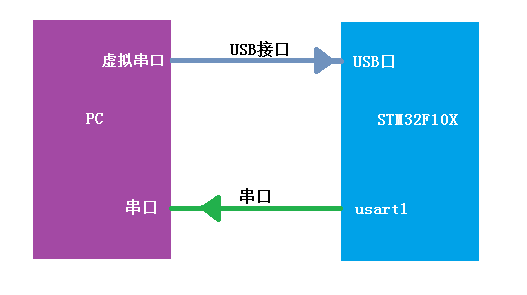
由上图可知,PC通过虚拟串口发送数据到STM32 usb口,STM32再通过usart1发送数据到PC串口。我们做项目时,只用USB虚拟串口即可。所以我们现在需要把串口发送部分删除。把USB做为一个COM口来使用。我们要如何使用这个USB口呢?demo中是把USB发送数据做了一个缓存,先把要发送的数据存入缓存中,然后由USB自动发送出去。而接收部分是直接通过串口透传。我们在应用时就需要用到两个FIFO,1是发送,这个和demo方式是样;2是接收,接收也做一个缓存,我们通过查询来判断是否收到新数据。这下大家应该明白为什么使用两个FIFO了。 我这里有写好的FIFO库函数可直接使用Queue.c文件。
现在开始修改:
1,stm32_it.c 更名为usb_it.c删除无用代码,只保留usb中断函数,和唤醒函数。代码如下:
代码1
1 /* Includes ------------------------------------------------------------------*/
2 #include "hw_config.h"
3 #include "usb_lib.h"
4 #include "usb_istr.h"
5
6
7 /*******************************************************************************
8 * Function Name : USB_IRQHandler
9 * Description : This function handles USB Low Priority interrupts
10 * requests.
11 * Input : None
12 * Output : None
13 * Return : None
14 *******************************************************************************/
15 #if defined(STM32L1XX_MD) "| defined(STM32L1XX_HD)|| defined(STM32L1XX_MD_PLUS)|| defined (STM32F37X)
16 void USB_LP_IRQHandler(void)
17 #else
18 void USB_LP_CAN1_RX0_IRQHandler(void)
19 #endif
20 {
21 USB_Istr();
22 }
23
24 /*******************************************************************************
25 * Function Name : USB_FS_WKUP_IRQHandler
26 * Description : This function handles USB WakeUp interrupt request.
27 * Input : None
28 * Output : None
29 * Return : None
30 *******************************************************************************/
31
32 #if defined(STM32L1XX_MD) || defined(STM32L1XX_HD)|| defined(STM32L1XX_MD_PLUS)
33 void USB_FS_WKUP_IRQHandler(void)
34 #else
35 void USBWakeUp_IRQHandler(void)
36 #endif
37 {
38 EXTI_ClearITPendingBit(EXTI_Line18);
39 }
2,修改代码hw_config.c删除无用代码,新建立2组,读FIFO和写FIFO的函数。后面会用到。
代码如下:
1 /* Includes ------------------------------------------------------------------*/
2
3 #include "usb_lib.h"
4 #include "usb_prop.h"
5 #include "usb_desc.h"
6 #include "hw_config.h"
7 #include "usb_pwr.h"
8 #include "Queue.h"
9
10
11 /* Private typedef -----------------------------------------------------------*/
12 /* Private define ------------------------------------------------------------*/
13 /* Private macro -------------------------------------------------------------*/
14 /* Private variables ---------------------------------------------------------*/
15 ErrorStatus HSEStartUpStatus;
16 USART_InitTypeDef USART_InitStructure;
17 EXTI_InitTypeDef EXTI_InitStructure;
18
19
20 #define USB_COM_RX_BUF_SIZE (1024 + 256)
21 #define USB_COM_TX_BUF_SIZE (1024 + 256)
22
23 static QUEUE8_t m_QueueUsbComRx = {0};
24 static QUEUE8_t m_QueueUsbComTx = {0};
25 static uint8_t m_UsbComRxBuf[USB_COM_RX_BUF_SIZE] = {0};
26 static uint8_t m_UsbComTxBuf[USB_COM_TX_BUF_SIZE] = {0};
27
28 static void IntToUnicode (uint32_t value , uint8_t *pbuf , uint8_t len);
29 /* Extern variables ----------------------------------------------------------*/
30
31 extern LINE_CODING linecoding;
32
33 /* Private function prototypes -----------------------------------------------*/
34 /* Private functions ---------------------------------------------------------*/
35 /*******************************************************************************
36 * Function Name : Set_System
37 * Description : Configures Main system clocks & power
38 * Input : None.
39 * Return : None.
40 *******************************************************************************/
41 void Set_System(void)
42 {
43 GPIO_InitTypeDef GPIO_InitStructure;
44
45 QUEUE_PacketCreate(&m_QueueUsbComRx, m_UsbComRxBuf, sizeof(m_UsbComRxBuf));
46 QUEUE_PacketCreate(&m_QueueUsbComTx, m_UsbComTxBuf, sizeof(m_UsbComTxBuf));
47
48 /* Enable USB_DISCONNECT GPIO clock */
49 RCC_APB2PeriphClockCmd(RCC_APB2Periph_GPIO_DISCONNECT, ENABLE);
50
51 /* Configure USB pull-up pin */
52 GPIO_InitStructure.GPIO_Pin = USB_DISCONNECT_PIN;
53 GPIO_InitStructure.GPIO_Speed = GPIO_Speed_50MHz;
54 GPIO_InitStructure.GPIO_Mode = GPIO_Mode_Out_PP;
55 GPIO_Init(USB_DISCONNECT, &GPIO_InitStructure);
56
57 /* Configure the EXTI line 18 connected internally to the USB IP */
58 EXTI_ClearITPendingBit(EXTI_Line18);
59 EXTI_InitStructure.EXTI_Line = EXTI_Line18;
60 EXTI_InitStructure.EXTI_Trigger = EXTI_Trigger_Rising;
61 EXTI_InitStructure.EXTI_LineCmd = ENABLE;
62 EXTI_Init(&EXTI_InitStructure);
63
64
65 }
66
67 /*******************************************************************************
68 * Function Name : Set_USBClock
69 * Description : Configures USB Clock input (48MHz)
70 * Input : None.
71 * Return : None.
72 *******************************************************************************/
73 void Set_USBClock(void)
74 {
75 /* Select USBCLK source */
76 RCC_USBCLKConfig(RCC_USBCLKSource_PLLCLK_1Div5);
77
78 /* Enable the USB clock */
79 RCC_APB1PeriphClockCmd(RCC_APB1Periph_USB, ENABLE);
80 }
81
82 /*******************************************************************************
83 * Function Name : Enter_LowPowerMode
84 * Description : Power-off system clocks and power while entering suspend mode
85 * Input : None.
86 * Return : None.
87 *******************************************************************************/
88 void Enter_LowPowerMode(void)
89 {
90 /* Set the device state to suspend */
91 bDeviceState = SUSPENDED;
92 }
93
94 /*******************************************************************************
95 * Function Name : Leave_LowPowerMode
96 * Description : Restores system clocks and power while exiting suspend mode
97 * Input : None.
98 * Return : None.
99 *******************************************************************************/
100 void Leave_LowPowerMode(void)
101 {
102 DEVICE_INFO *pInfo = &Device_Info;
103
104 /* Set the device state to the correct state */
105 if (pInfo->Current_Configuration != 0)
106 {
107 /* Device configured */
108 bDeviceState = CONFIGURED;
109 }
110 else
111 {
112 bDeviceState = ATTACHED;
113 }
114 /*Enable SystemCoreClock*/
115 // SystemInit();
116 }
117
118 /*******************************************************************************
119 * Function Name : USB_Interrupts_Config
120 * Description : Configures the USB interrupts
121 * Input : None.
122 * Return : None.
123 *******************************************************************************/
124 void USB_Interrupts_Config(void)
125 {
126 NVIC_InitTypeDef NVIC_InitStructure;
127
128 NVIC_InitStructure.NVIC_IRQChannel = USB_LP_CAN1_RX0_IRQn;
129 NVIC_InitStructure.NVIC_IRQChannelPreemptionPriority = 2;
130 NVIC
查看评论 回复
"STM32 USB虚拟串口 -"的相关文章
- 上一篇:STM8的GPIO驱动 -
- 下一篇:C语言在单片机开发中的优势 -


